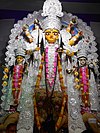Nazrul Geeti
| Nazrul Sangeet | |
|---|---|
 Nazrul teaching Nazrul Sangeet | |
| Etymology | Songs and music composed by Kazi Nazrul Islam |
| Cultural origins | Early 20th century, Bengal |
| Regional scenes | |
| Bangladesh and India (West Bengal, Tripura, Jharkhand and Assam) | |
Nazrul Sangeet (
Background
Nazrul showed the symptoms of keen poetic and musical talent at his tender age and started writing songs when he was a member of a Leto group (Folk Musical Group). Following Kazi Bazle Karim, his uncle and a leader of a Leto group, he became an expert in composing songs and setting them to tunes. Joining the Leto group enhanced his musical career and put a significant impact on shaping his future musical life. At a very young age he was excelled in composing songs in different languages, apart from the Bengali language. He met Satish Kanjilal, a teacher of
Nazrul Islam's musical style
Revolutionary mass music
The mass music and poems of Kazi Nazrul Islam have been widely used during the Indian Independence Movement and Bangladesh Liberation War. The music is highly motivational and revolutionary in nature with strong and powerful words and captivating tunes. It talks about the extremities of everything. The lyrics of those songs are provoking, as they talk against conservatism and about life on a broader parameter of philosophy and spirituality. The beauty of Nazrul's mass music lies in the freedom of its expression, which also drew immense criticism. However, those who understood its philosophy praised the courage and straightforwardness.

Ghazal
Nazrul's acquaintance with the tradition of Persian
Historical influence
Nazrul used his music as a major way of disseminating his revolutionary notions, mainly by the use of strong words and powerful, but catchy, tunes. Among the revolutionary songs, Karar Oi Louho Kopat (Prison-doors of Steel) is best known and has been used in several movies, especially those made during the pre-independence period of Bangladesh.

Nazrul Geeti has recently been translated and recorded in Oriya (an Indian language) in the form of a studio album.
Notable songs
This list of songs or music-related items is incomplete; you can help by adding missing items. (January 2021) |
- Dolan Chapa (name of a faintly fragrant monsoon flower), poems and songs, 1923
- Bisher Bashi (The Poison Flute), poems and songs, 1924
- Bhangar Gan (The Song of Destruction), songs and poems, 1924 proscribe in 1924
- Chhayanat (The Raga of Chhayanat), poems and songs, 1925
- Chittanama (On Chittaranjan), poems and songs, 1925
- Samyabadi (The Proclaimer of Equality), poems and songs, 1926
- Puber Hawa (The Eastern Wind), poems and songs, 1926
- Sarbahara (The Proletariat), poems and songs, 1926
- Sindhu Hindol (The Undulation of the Sea), poems and songs, 1927
- Jinjir (Chain), poems and songs, 1928
- Pralaya Shikha (Doomsday Flame), poems and songs, 1930 proscribed in 1930
- Gumaite Dao Sranto Rabire (Let the tired Sun(Rabindranath) sleep), poems and songs, 1941.
- Shesh Saogat (The Last Offerings), poems and songs, 1958
- Notuner Gaan (The Song of Youth), 1928, National March of Bangladesh
- O Mon Romzaner Oi Rozar Sheshe Elo Khushir Eid, composed for Abbasuddin Ahmed, 1932
- Tribhubaner Priya Muhammad(Muhammad the beloved of three dimensions), composed for Abbasuddin Ahmed, 1935
Notable singers of Nazrul Sangeet
- Abbasuddin Ahmed
- Shusmita Anis
- Ferdous Ara
- Firoza Begum
- Asha Bhosle
- S. D. Burman
- Ajoy Chakrabarty
- Niaz Mohammad Chowdhury
- Alaka Das
- Chittaranjan Das
- Manas Kumar Das[3]
- Sudhin Das
- Tapas Kumar Das[4]
- Kamal Dasgupta
- Kanan Devi
- K C Dey
- Manna Dey
- Purabi Dutta
- Anup Ghoshal
- Anup Jalota
- Nashid Kamal
- Sabiha Mahboob[5]
- Sadya Afreen Mallick
- Namrata Mohanty
- Manabendra Mukhopadhyay
- Sandhya Mukhopadhyay
- Mohammed Rafi
- Ferdausi Rahman
- Juthika Roy
- Haimanti Shukla
- Madhuri Chattopadhyay
- Ila Basu
- Shaheen Samad
- Kumar Sanu
- Indrani Sen
- Anuradha Paudwal
- Nilufar Yasmin
- Ila Ghosh
- Angur Bala devi
- Indu Bala
- Shanta Apte
- Jnanendra Prasad Goswami
References
- ^ "Nazrul: The ever-shining beacon". The Daily Star. 31 August 2013. Archived from the original on 26 December 2013. Retrieved 26 December 2013.
- ISBN 984-555-167-X.
- ^ Dey, Saurav (4 September 2014). "The depth of Nazrul's lyrics attracts me..." The Daily Star. Archived from the original on 18 April 2017. Retrieved 18 April 2017.
- ^ রবীন্দ্রনাথকে হৃদয়ে ধারণ ও নজরুল চেতনায় উজ্জীবিত হতে হবে - See more at: http://www.comillarkagoj.com/2016/05/29/23242.php#sthash.F79WClxv.dpuf. Comillar Kagoj (in Bengali). 29 May 2016. Archived from the original on 18 April 2017.
- ^ "Sabiha Mahboob talks to VOA Bangla". VOA. 28 June 2008. Archived from the original on 16 August 2021. Retrieved 16 August 2021.


